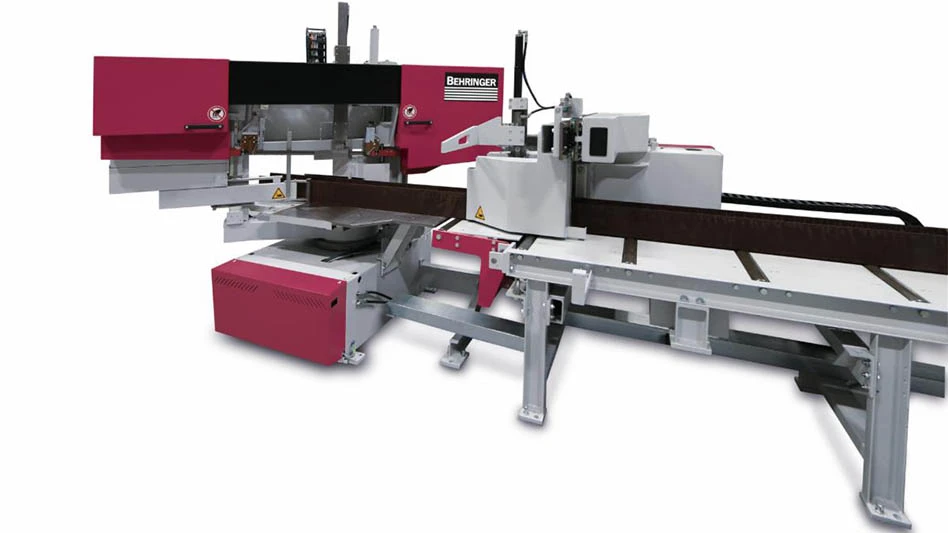 Universal Machining Industries Inc. (UMII) has built its reputation on quality products and its production environment. During the last decade, the mid-sized job shop has made continual investments in aerospace manufacturing technologies, transitioning from primarily stand-alone vertical machining centers to horizontal machining centers in automated cells. During the past four years, the company has experienced a 60% increase in production.
Universal Machining Industries Inc. (UMII) has built its reputation on quality products and its production environment. During the last decade, the mid-sized job shop has made continual investments in aerospace manufacturing technologies, transitioning from primarily stand-alone vertical machining centers to horizontal machining centers in automated cells. During the past four years, the company has experienced a 60% increase in production.
For Steve Trubenbach, owner and general manager of the Muenster, Texas, company, investments help show potential customers how his company stands out.
“Aerospace manufacturers from around the world are highly sensitive to Six Sigma, just-in-time (JIT), and return-on-investment (ROI),” he explains. “When potential customers visit your facility and see too much labor, inventory, work-in-progress (WIP), and tool expenditures, they know you won’t be offering the best price possible. They understand that stand-alone machines aren’t efficient.”
 Trubenbach says the industry has become a global marketplace, putting UMII in direct competition with low-cost countries. The only way to combat the shift and keep customers, he says, is through technology, especially automation. He began purchasing automated machining systems from Makino in 2009, saying they have freed up labor and increased efficiency.
Trubenbach says the industry has become a global marketplace, putting UMII in direct competition with low-cost countries. The only way to combat the shift and keep customers, he says, is through technology, especially automation. He began purchasing automated machining systems from Makino in 2009, saying they have freed up labor and increased efficiency.
“Not only has customer satisfaction improved,” Trubenbach says, “but we’ve also gained better control over our workflow, leaving fewer dollars sitting idly on the shop floor.”
Adjusting to utilization
Approximately 70% of UMII’s production is dedicated to aerospace; however, the company maintains a healthy balance of orders within the commercial product and oil and gas markets as well. Its product mix is typically composed of aluminum, steel, carbon steel, plastic, and some hard metals. UMII’s recent list of achievements include AS9100 Rev. C and ISO9001-2008 certifications, a 24,000ft2 expansion to its current 57,000ft2 facility, and 98.5% on-time delivery and 99.8% quality acceptance rates.
Much of that success can be traced straight to automation, but the transition to automated production was a gradual one, Trubenbach explains.
“In the early days, we thought we were doing well with stand-alone verticals,” he says. “The quality was good, and we were pushing out what we thought to be a healthy part volume. But that perception was quickly challenged when we purchased our first horizontal and saw the benefits of the pallet changer and gravitational chip evacuation. The utilization rates of the horizontal were more than twice that of the verticals, while using less labor, fewer setups, and achieving better part quality. It was an eye-opening experience.”
One key benefit that Trubenbach noted during UMII’s transition from vertical to horizontal machining centers was the change in labor and product flow. Operators could manage two machines simultaneously, while inventory and WIP circulated through the facility faster. These observations, combined with continual customer pressures, eventually led UMII to evaluate automation as a solution for JIT delivery and enhanced profitability.
Proving out automation
Following extensive market research and ROI calculations, UMII made its first investment in automation with the purchase of a 60-pallet Makino Machining Complex (MMC2) and five Makino a61 horizontal machining centers. This acquisition soon enabled the company to accomplish quick turnaround production that addressed customer demands for shorter lead-times and reduced part costs.
 “Our market research came up with a wide variety of technology options, most of which required the support of separate vendors for the automation system, machines, and cell control software,” Trubenbach says. “We favored Makino for its all-inclusive approach to automation. All features of the cell, including the MMC2, a61 machines and cell control software, are sourced, managed, and serviced by Makino, simplifying training and maintenance on the system.
“Our market research came up with a wide variety of technology options, most of which required the support of separate vendors for the automation system, machines, and cell control software,” Trubenbach says. “We favored Makino for its all-inclusive approach to automation. All features of the cell, including the MMC2, a61 machines and cell control software, are sourced, managed, and serviced by Makino, simplifying training and maintenance on the system.
“The a61 machines were installed prior to the arrival of the MMC2, allowing us to run production orders as quickly as possible. During installation of the MMC2, our operators went to Mason, Ohio, for training, minimizing our overall downtime. In total, the full system was installed in less than five weeks, and our operators were initiating production runs on day one.”
Since installation, UMII has reported consistent utilization rates of more than 90% from its a61 machines. In applications transferred from the stand-alone machines to the automated cell, the company can produce an average of 30% more parts in the same time while removing more material. Many of these gains come from the a61 machine’s design, which emphasizes reduced out-of-cut time through faster rapid moves, acceleration/deceleration rates, and tool changes. In some applications requiring substantial out-of-cut processes, cycle times are up to 20% faster than previous technologies.
The design of the a61 machines has also enabled a significant reduction in manual-labor at UMII. Its fourth-axis table, tombstone fixtures, and rigid cutting capabilities along axis extremities have enabled operators to fixture more parts per face with multi-face cutting access. As a result, parts require fewer setups and are produced with higher quality and consistency.
“Automation has had an overwhelmingly positive impact on our operators, creating a team atmosphere where each person shares in the success of the system,” Trubenbach says. “Running the cell only requires the attention of six operators per workday and can continue lights-out operation during holidays and weekends. The cell’s tool-monitoring capabilities provide us with an extra degree of quality assurance. The only difficulty in owning and operating the cell has been maintaining a continuous flow of raw materials.”
After realizing the full benefits and rapid ROI of automation, UMII expanded its capabilities with a second automated system in 2012.
The new cell features a similar design with an MMC2 pallet-handling system; however, the company opted for a 54-pallet system with five of Makino’s larger a61nx horizontal machining centers. Containing optional, extended Y-axis travel and advanced technologies, the a61nx machines provide a greater work-zone capacity and up to 10% faster cycle times.
“With two MMC2 cells available, we’re able to run larger lot sizes on the a61nx cell and smaller lots on the a61 cell,” Trubenbach says. “A secondary benefit is the interchangeability of pallets between cells. So in the event that schedules were to change dramatically, we have the flexibility to rapidly exchange orders between cells to meet these demands.”
Flow control
Higher speeds and production capacity have improved customer satisfaction, but UMII sees the biggest competitive advantages from automation in improved workflow management and just-in-time delivery.
 “With stand-alone machining centers, there’s very little flexibility in production scheduling. The time and cost associated with machine and part setups force manufacturers to focus on large batch production, which also causes high volumes of idle inventory and work in progress. In many cases, a full return on these orders won’t be seen until months after the initial production run. This type of situation can skew a company’s balance sheets, making it difficult to accurately reinvest that money into the business. It also challenges a company’s ability to react more quickly to small batch orders that might follow after the initial large production run.”
“With stand-alone machining centers, there’s very little flexibility in production scheduling. The time and cost associated with machine and part setups force manufacturers to focus on large batch production, which also causes high volumes of idle inventory and work in progress. In many cases, a full return on these orders won’t be seen until months after the initial production run. This type of situation can skew a company’s balance sheets, making it difficult to accurately reinvest that money into the business. It also challenges a company’s ability to react more quickly to small batch orders that might follow after the initial large production run.”
UMII’s transition into automation has eliminated much of these scheduling and inventory concerns by letting the company focus on smaller batch production. A critical component to this capability has been the MMC2’s MAS-A5 cell control software, which allows operators to easily store program, fixture, and tooling data for each part order into the cell’s database and retrieve them on the fly.
By producing smaller batches for immediate sale, UMII has gained access to more immediate funds that can be reinvested into the company through additional manpower, training, and technology. Since investing in automated capabilities, the company also has reported a decrease in raw material inventory of approximately 25% and about a 30% drop in WIP.
Another cost-saving factor has been improved tool management. Where tool inspection was once the responsibility of an operator, the MMC2 systems can now automatically monitor tool degradation to help control tool costs and part quality.
“These investments in automated capabilities have demonstrated our commitment to offering customers the quickest turnarounds and lowest possible cost,” Trubenbach says. “Several customers who are dealing with prototype parts have stated that these capabilities have played a crucial role in their time to market and overall market share. This is exactly the type of impression we hope to leave with our customers.”
Hard work & dedication
While Trubenbach recognizes and appreciates the importance of technology in its manufacturing operations, he also emphasizes the significance and demand for dedicated and skilled labor.
“There’s a human factor to this industry that is too often underestimated and underappreciated. For many, manufacturing is more than just a career – it’s their passion and livelihood. Our employees come into the shop every day and work tirelessly to ensure that our customers are happy with the product we deliver. They truly put their heart into the job. We strive to be as competitive as possible so that each and every one of us can come back the next day and do what we enjoy. It is in large part through the hard work and dedication of our employees that we have been able to grow and expand at the rate we have, while continuing to offer the level of quality that our customers have come to expect from UMII.”
Trubenbach says the company plans to grow its Tier 1 customer base within the aerospace market. By maintaining a commitment to industry-leading delivery and part cost, the company believes it has established a competitive edge in the global market.
“Automation was an intimidating investment at first, but after spending several years learning and adapting, I can confidently say that it’s our future,” Trubenbach says. “To succeed, you have to have the right tools and people. We have both.”
Universal Machining Industries Inc.
www.universalmachiningind.com
Makino Inc.
www.makino.com
IMTS 2014 booth #S-8700

Explore the June 2014 Issue
Check out more from this issue and find your next story to read.
Latest from Aerospace Manufacturing and Design
- Shaft coupling clamps
- #46 Lunch + Learn Podcast with SMW Autoblok
- Gleason Corp. acquires the Intra Group of Companies
- Thread milling cutter reduces cutting pressure, vibration
- Malaysia Aviation Group orders 20 more Airbus A330neo widebodies
- More displacement from space-tested piezo actuators
- Textron Aviation to bring its largest-ever lineup to 2025 EAA AirVenture
- Qualified materials for 3D-printing mission-critical applications





